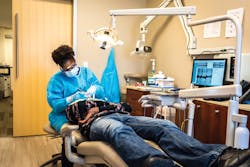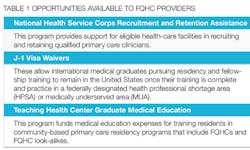Delivering care in a FQHC: Health centers offer employment opportunities in a public health setting
By Christine Nathe, RDH, MS
Many opportunities continue to develop for dental hygiene employment. One such opportunity is employment within federally qualified health centers (FQHCs), which are sometimes referred to as community health centers. FQHCs are safety net clinics for low-income individuals and receive grants from the government, including the Health Resources and Services Administration, to serve this population.
FQHCs must serve an underserved area or population, offer a sliding fee scale, provide comprehensive services (which may or may not include comprehensive dental care), have an ongoing quality assurance program, and have a governing board of directors. Certain tribal organizations and FQHC "look-alikes" (i.e., an organization that meets PHS eligibility requirements, but does not receive grant funding) also may receive special publicly funded reimbursement. FQHCs and FQHC look-alikes are important providers in rural areas. Of the over 22 million Americans who receive care from health centers, approximately a third reside in rural communities. State level health-care facility maps are available at http://bit.ly/29ifaKE.
FQHCs can accept public funding, both Medicaid, which is the program that generally funds dental care for low-incomes populations, and Medicare coverage.
FQHC requirements
By law, health center grantees and look-alikes may charge no more than a nominal fee to individuals whose incomes are below the federal poverty level (FPL). Individuals with incomes between 101% and 200% of FPL must be charged using a sliding fee scale with discounts based on patient family size and income. FQHC grantees must:
• Offer services to all persons, regardless of ability to pay;
• Establish a sliding-fee discount program;
• Be a nonprofit or public organization;
• Be community based, with the majority of their governing board of directors composed of their patients;
• Serve a medically underserved area or population;
• Provide comprehensive primary care services;
• Have an ongoing quality assurance program.
For more information on the detailed 19 program requirements that HRSA-funded health centers must meet, please visit bphc.hrsa.gov/programrequirements.
Provider opportunities
FQHCs are eligible for a variety of federally funded programs that can be used to help attract and retain providers, including dental hygienists. Table 1 describes the available programs that may be available to dental hygienists.
Dental services at FQHCs
All health center program grantees provide preventive dental services such as basic dental screening, recommendations for preventive intervention, oral hygiene instruction and related oral health education, oral prophylaxis as necessary, and topical application of fluorides. In 2014, over 950 health centers reported providing additional dental services, such as fillings and single-unit crowns, nonsurgical endodontics, extractions, periodontal therapies, and bridges or dentures, either directly or through formal written contract/agreement. According to Elizabeth Senerchia, HRSA public affairs specialist, "This year, HRSA will invest approximately $150 million to support increased access to oral health services in an estimated 420 health centers. This funding opportunity will enable health centers to expand oral health-care services through funding new onsite dental providers including dentists, dental hygienists, and dental therapists."
Dental hygiene employment
In 2014, health centers employed nearly 12,900 full-time equivalent (FTE) dental services staff. This included over 3,700 dentists, nearly 1,700 dental hygienists, and nearly 7,500 dental assistants, aides, and/or techs. These dental professionals provided dental care to nearly 4.8 million patients. Health centers are independent organizations, so they make the hiring decisions regarding dental hygiene workforce.
FQHCs are community health clinics that serve the underserved, specifically those populations with low incomes. There are various opportunities around the country to find positions within these clinics. This is one more setting available to dental hygienists interested in working in public health.
Please visit the Health Center Program web page "Oral Health and Primary Care Integration" (bphc.hrsa.gov/qualityimprovement/clinicalquality/oralhealth/index.html) for resources and information related to the work health centers are doing to increase access to oral health care. For more information on HRSA oral health initiatives, visit the HRSA Oral Health webpage (hrsa.gov/publichealth/clinical/oralhealth/index.html).
CHRISTINE NATHE, RDH, MS, is director at the University of New Mexico, Division of Dental Hygiene, in Albuquerque, N.M. She is also the author of "Dental Public Health Research" (www.pearsonhighered.com/educator), which is in its third edition with Pearson. She can be reached at [email protected] or (505) 272-8147.
Sources
Elizabeth Senerchia, HRSA Public Affairs Specialist
http://www.hrsa.gov/healthit/toolbox/RuralHealthITtoolbox/Introduction/qualified.html


